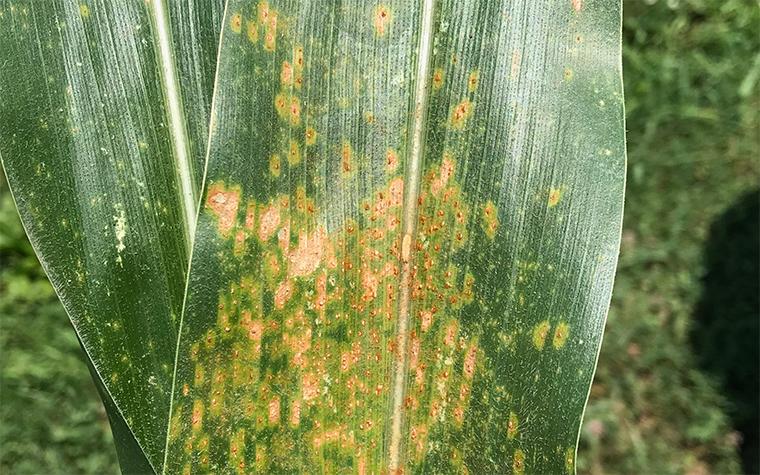Milk production may be sensitive to changes.
PALMYRA, Mo. – Southern rust, a fungal disease, can reduce nutrients and lower digestibility in infected corn fed to livestock, says University of Missouri Extension field agronomist Nick Wesslak.
Early dry down caused by southern rust can cause problems with proper silage packing, which increases risk of poor fermentation and higher mold and yeast populations.
Corn infected with southern rust may be more of a concern for the dairy industry than the beef industry, says Eric Bailey, MU Extension state beef nutrition specialist. The dairy industry relies heavily on corn silage, and milk production is highly sensitive to subtle changes in nutritive value.
Leads to other diseases
While southern rust (Puccinia polysora) does not produce known mycotoxins, it opens the door for other stalk and ear rot diseases that produce mycotoxins in corn-based feedstuffs such as silage, grain and stover, says MU Extension veterinary toxicologist Tim Evans.
He recommends running a mycotoxin panel screening before feeding forage or grain infected with southern rust. Producers also should consider diluting with clean feedstuff and using other mycotoxin mitigation strategies as needed.
Southern rust spreading in Missouri
Southern rust was found in 25 Missouri counties in the 2025 growing season, according to the Corn IPM Pipe, a collaboration of many universities.
The wet start of the growing season contributed to southern rust being confirmed earlier than usual.
Southern rust grows well in warm weather (77-88 F) and high humidity. It is identified by orange to brown raised lesions on the top leaf surface, and yellow flecking on the leaf underside, but no pustules, says MU Extension plant pathologist Mandy Bish. Open lesions leave an orange to brown mark on fingers when touched or rubbed.
Looks like common rust
Southern rust and common rust symptoms are similar, and the diseases are difficult to distinguish in early stages. It also is common to see both pathogens infesting the same leaf, says Bish.
Wesslak recommends sending samples to a diagnostic lab, such as the MU Plant Diagnostic Clinic, to determine which species are present when symptoms first arise.
Neither rust species overwinters in the Missouri. Both move northward from tropical areas as the growing season progresses.
Early dry down
Southern rust infestation often leads to early dry down (premature plant death) due to orange pustules bursting through the corn plants epidermal leaf tissue. This interferes with the plant’s ability to regulate water loss.
Optimal moisture content for corn silage is generally between 60% and 70%. Southern rust may lead to silage that is drier than expected based on calendar date, says Bailey. When silage is too dry, oxygen cannot be kept out of the pile and silage does not pack to the proper density of less than 15 pounds of dry matter per cubic foot.
“Since silage has been put in the bunker/pit/silo already this fall, there is not a whole lot we can do,” he says.
Yield losses are due to the pathogen feeding off plant photosynthates (glucose) and reductions in total plant photosynthetic leaf area. Yield losses begin even before 5% of the ear leaf is covered with lesions.
Reduction in grain yield also means a reduction in starch (grain contributes most of the starch in an ensiled corn feedstuff) and a reduction in energy. Also, digestibility can have declines of more than 10%.
Testing is advised due to the complications that arise from southern rust infection. Considering silage inoculum products when using southern rust contaminated corn in silage, says Evans. When testing corn-based feedstuffs, have a quantitative nitrate test performed as well.
If you have concerns about southern rust’s effect on your feedstuff, consider a fermentation quality analysis, says Bailey.
Examine results closely: Lactic acid should be between 4% and 6%; butyric acid should be less than 0.25%; and ammonia should be less than 12%. If you receive an unfavorable fermentation profile, contact your local MU Extension livestock specialist for help in developing a plan to use that silage.
To learn more about southern rust and diseases that can cause mycotoxins, visit the Crop Protection Network website.
Photo
Southern rust. Note the densely packed orange-tan pustules on the upper leaf surface. Photo submitted with sample from Vernon County, Mo.
